

OCG Creative is excited to announce that our Partner/Vice President, Jill Rutherford has been awarded the 2017 Saleswoman of the Year Award by the Professional Saleswomen of Nevada (PSN). Each year, this award is presented to a woman in the Northern Nevada community that excels in her profession of sales and marketing. On May 9th 2017, PSN held their 30th Annual Awards Luncheon and Fundraiser to publicly recognize and honor women in sales and marketing for their professional accomplishments, achievements, and advancements. There were five wonderful nominations at this year's event including: Kimberly Wade, Jill Rutherford, Robyn Nichols, Shari Pheasant, Staci Nauman, and the Junior Saleswoman of the year, Laney Fix.
According the the PSN website, PSN seeks nominations throughout Northern Nevada of those women who:

Jill's dedication to her business, family, and community shine through in her everyday life. She's someone that always meets you with a smile and genuinely enjoys what she does. As the Vice President of OCG Creative and mom of two, active kids, Jill also knows first-hand what it means to cultivate and foster long-lasting relationships, both in business and life. In fact, one of her favorite quotes highlights her life philosophy perfectly:
"One of my favorite sayings is, ‘it is a rare person who can take care of business while taking care of hearts,’ and that is exactly how I live my life. I truly believe that the more enriching your relationships, the more successful your business.”- Jill Rutherford

Jill merged with OCG Creative in 2008, fully immersing herself in the fast-paced landscape of digital marketing. Prior to that, she owned her own advertising agency for 15 years, serving a wide variety of clients throughout Northern Nevada. Today, OCG Creative is a full-service marketing company that specializes in web design, internet marketing, and print solutions. As a seasoned marketing professional, Jill prides herself on providing the best possible marketing services and support for her clients. When she’s not leading her team or jugging projects, Jill enjoys volunteering in the community with the Reno Rodeo Association, which she has done for 23 years, and donating time and marketing services to the Down Syndrome Network.
After a wonderful lunch was served, the afternoon also included a speech from keynote speaker, Dr. Erin Oksol, who is an expert on cognitive-behavioral psychology. We all left with an important message of adapting a "growth" mindset. It was a great message for all of us, and something that Jill, as a marketing professional and leader, exhibits in all that she does. Read more about Jill Rutherford at the Northern Nevada Business Weekly.
 When you work in a web design company, in digital marketing, or in SEO, Google Algorithm updates are often a trigger for mild panic attacks. You hold your breath as you start to see the effects of the change. You cry a little if your traffic starts to tank, or you jump for joy if your traffic sees a large rise. The good news, though, is Google’s Penguin 4.0 signal change might just work as well as a meditation ritual for reducing your stress.
When you work in a web design company, in digital marketing, or in SEO, Google Algorithm updates are often a trigger for mild panic attacks. You hold your breath as you start to see the effects of the change. You cry a little if your traffic starts to tank, or you jump for joy if your traffic sees a large rise. The good news, though, is Google’s Penguin 4.0 signal change might just work as well as a meditation ritual for reducing your stress.
Google’s Penguin signal has been focused on the effects of spammy links since 2012. Like the rest of the internet, the signal has evolved a lot since its original release - and for the better. The largest complaint for prior Penguin versions was the intermittent and inconsistent penalization of bad links.
As it ran the Penguin algorithm in waves, Google only assessed and removed website penalties periodically. Meaning, if you were a site that had disavowed your bad links, you may not see any removal of your penalty for several weeks or even months down the road. Your site’s rankings, in the meantime, we're still being penalized. In your web design and content strategy, you then were stuck waiting for Google’s next wave before you saw results of the positive work you had done since the disavowal.
Painful timelines aside, Google’s older Penguin versions also implemented a one-size-fits-all policy towards spam links. If you received link penalties on one page, your entire domain was penalized in the rankings. Now this small problem, on top of the long timeline before your penalty could be removed, became a massive migraine for web design companies and strategists.
Penguin 4.0 was slowly released throughout the fall of 2016, and has now been made core to Google’s algorithm. The new release, deemed the ‘Real Time’ update, seeks to expedite the link penalty process. Operating in almost ‘real time’, Google will now assess and remove penalties for websites much more quickly. If you have a poor web design company who with many spammy links, this update may have killed your traffic. Sorry. While you previously may have been able to go for longer periods before penalties were assessed to your site, this is no longer going to fly with Google. If you have a great web design company and a solid set of credible and clean backlinks, it’s your turn to jump and cheer. Google can now reward your good behavior by quickly decreasing the rankings of sites with spammy links, thereby increasing your rankings. Free traffic without additional effort - just for doing the right thing in your web design to start with!
Penguin 4.0 also removed the one-size-fits-all policy and removed the automatic penalty to the entire domain. Now, Google will not confirm that this means only the page that the link appeared on will be penalized. But, it is likely that your entire website and rankings will not be penalized for one page with bad links. Google also has become smarter and more selective around reviewing and interpreting your links. For example, if your website is in an industry where spammy links are plentiful across competitors, rather than knocking all of these website’s rankings, Google may just decrease the weight of the links in its ranking algorithm. This is just one part of how Google has become more semantic and understanding of the subtleties of linking strategies that a web design company uses.
The trick to adapting to Google’s changes and staying on top of your rankings is often by utilizing a creative Reno web design company. With a full-time team of designers, developers, and strategists, a web design company can stay in the loop with Google’s changes. They can also keep your site and link strategy evolving with the Penguin releases. OCG Creative provides a full team to help you with Reno web design, content strategy, SEO, and ongoing internet marketing initiatives. Call us. We’d love to help. (775) 324-1644

With the rise of digital technology, it seems that each year there's a new security breach that puts the previous year to shame, and 2016 was no exception. Except now, end-users face even bigger threats when it comes to data theft: the bad guys now have all the time and resources they need to decrypt the account passwords.
It seems to have become so common place that inevitably each of us will have at least one account/password combination that's in the wrong hands. While we can't prevent that from happening as end-users, we do have the ability to make that information outdated sooner, and thus, less useful. Good password habits are the best defense.
Over time, the bad guys have created huge dictionaries of previously cracked passwords that are used first in attempt to crack their latest cache of stolen account data. Creating longer and meaningless passwords is a good start, but as humans with limited password combinations, that's not so easy to do.
Using a password management service like 1Password does a great job of generating meaningless and difficult to crack passwords that are unique between all of your accounts. The downside is that they don't always work with every service and they usually have monthly fees.
Using a password generator utility like PWGen can be a big help. It's a free and open source utility you can run locally to have it can create lots of cryptographically-secure passwords for you to choose from with minimal effort. This type of tool makes it easy for users to ensure they have unique, secure passwords for every account that gets changed often.
With the ability of cracking software to churn through billions of guesses per second, using secure passwords by themselves isn't always enough. Using 2-factor authentication can add an additional layer of protection. This added layer requires not only a username and password to gain access to a site but also an additional piece of information like a constantly changing secret key.
Google Authenticator is a useful tool for 2FA that's widely supported among different applications and services (there are even WordPress plugins to support it like this one here). Once the application or service is configured to require a Google Authentication key, the user provides their usual username/password combination along with the randomly generated key displayed in the smart phone app for that service.
Overall, the best way to keep your passwords secure is to generate unique, randomized combinations that are cryptographically-secure. If you pair that with 2-factor authentication, you should be on your way to a much more secure password management system.
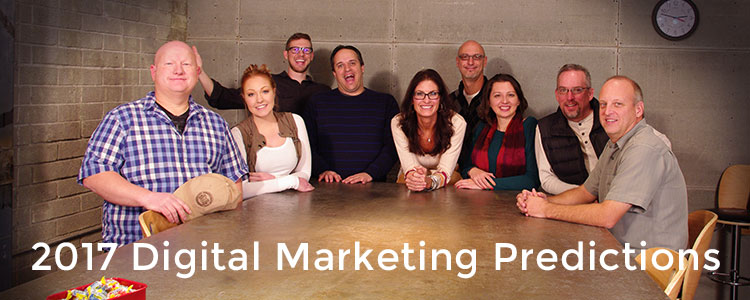
With a new year on the horizon, the OCG Creative team has collaborated to give our 2017 Digital Marketing Predictions. While the digital marketing landscape is fast-paced and ever-changing, we wanted to take a moment to pause and reflect on 2016. Here's some our best insights of what we think will be important in the upcoming year.
One of our marketing predictions for 2017 involves marketers needing to focus more on human language searches. “Digital assistant” platforms like Siri, Google Now and Cortana are increasing in popularity. For these, “voice search” is the obvious interface, but even in the search bar, Googlers are taking a more conversational tone. For some time, Google has been including a snippet at the top of the SERP (that’s search engine results page, for you non-nerds), answering direct questions like, “What is science?" SEOs are still somewhat mystified as how to reliably win that spot, but human phrasing of the search definitely plays a role. It’s not among the results for every search, but the Google Snippet will only become more common in 2017. Another one of the marketing predictions we can expect to see are that there will be constant, significant (albeit subtle) changes to the look and color scheme of Google’s SERP. The reason seems to be de-emphasizing organic rankings in favor of Adwords results. We already saw major moves in that direction throughout 2016, including some searches that only display 9 results instead of the usual 10. Finally in 2017, say goodbye to unsophisticated Internet marketing campaigns. The internet is still represents the most cost-effective, highest ROI marketing opportunities in human history. But, technology and the fierce competitive landscape have reached a point where home-brew websites without a real plan just don’t produce results like they once could. – Joe Ross, President at OCG Creative
Brand strategists will focus more on the message and less on the look. With all roads leading to “content” online, companies will need to have a better understanding of who they are, what they do, why they do it and who their perfect client is. The days of being a pretty face with no substance are gone! You better be able to back that great look up with relatable messaging. – Jill Rutherford, Vice President
If you thought 2016 was the year of mobile web, think again. 40% of Black Friday sales came via a mobile device. That's up almost 10% from the previous year. Mobile search and mobile optimization should, therefore, be a top priority for digital marketers in the year 2017. If your phone was glued to your had by now, it will be. – Mike Rollman, Sales
It seems that every year there's a new security breach that puts the previous year to shame and 2016 was no exception. One of the biggest threats facing end-users when their service provider succumbs to system data theft, is that the bad guys now have all the time and resources they need to decrypt the account passwords. It seems to have become so common place that inevitably each of us will have at least one account/password combination that's in the wrong hands. While we can't prevent that from happening as end-users, we do have the ability to make that information outdated sooner and thus less useful. Good password habits are the best defense. – Rick Ross, VP R&D
High contrast print pieces are en vogue; even the classiest printed piece will look dull if it’s slathered in one type of coating no matter how modern or bleeding edge that coating seems to be. Mix it up, add variety to the piece. Spot UV set on smooth silk adds a brilliant way to give your viewer pause as they travel across a page. But here’s the trick, don’t just place this highlight on top of a picture or text and call it a day. Rather, use negative space wisely and create imagery that adds depth to the piece with shine. Don’t know what I mean, just ask and we’ll show you. – Charles Driver, Print Manager
In 2016, we saw a trend of websites being developed with minimal content, under the notion that “people don’t read anymore.” In reality, people do in fact read online, but they are choosy about what they spend their time on. This year, it’s going to become even more important to make content mobile friendly (with headings, bolding, and keywords) so that people can scan and find important information they need. If they find what they need, then they spend the time reading it. Removing content from sites hurts rankings, because that’s the majority of the algorithm that google uses to crawl sites. – Allyson Lambert, Content Strategist
In a fast paced world, people don't have time to pick up their dry cleaning much less wait for a slow loading web page to pop up. A recent study published by Google reveals that more than 7 in 10 people browse the web on their smartphones or computers and out of those people, 71% are browsing on a smart phone. Web designers should be thinking more about the mobile experience by designing sites that collapse down to an easy to read and fast loading mobile page. Designers should be placing content strategically on the page, the use of bright colors and bold fonts are going to be a must in 2017. Bold fonts and brights colors will help guide you readers' eyes through the page faster as well as giving them the important information that they need to know. Plus bright colors and bold typography are always great design solutions that will make any website fun and modern. People browsing the web on a mobile device want an instant solution, which also means they want to get the information they need just as fast. - Chelsea Bosco & Mason Fur, Designers
It is important to interpret and analyze any trends when it comes to the marketing world. This will allow you to make marketing predictions for years to come and you be able to prepare your business for the upcoming year.
Marketing can be overwhelming for small businesses and entrepreneurs just starting out. It can be hard to know where to start. A lot of the time, we get caught up in our own heads and miss opportunities while we're waiting for the “perfect” strategy or plan to appear in front of us. The reality is, we all have the ability to create our own success. It just depends on the actions and effort we're willing to put in to get there. The same holds true for internet marketing. We get back what we put in.
"The biggest risk you can take is taking no risk at all."
Creating a great marketing strategy takes a lot more these days than just creating a post card or brochure and sending it out to a mailing list. With a whole digital landscape at our fingertips, it can be easy to get overwhelmed and not know where to start. However, don't let the overwhelm stop you. The worst thing you can do for your business is to do nothing at all. Sometimes fear can paralyze us from taking the next actionable
Whenever I start a new project, I literally keep a quote on my desk that says “Done is better than perfect.” Often times, we don’t get started on a project because we think the outcome won’t be "the way we want it." This type of thinking is flawed because we're never truly "done" with anything in life. Every living organism on earth evolves, and the same holds true for marketing campaigns.
When you don’t jump on opportunities and stay proactive, you're literally missing out on opportunities generate new business and convert leads into clients. Don’t let yourself get caught up in your head or in the "what ifs". For example, consider that you delay a website launch by seven months. Well, that’s seven months that you missed out on potential opportunities. Getting organized and staying focused on your goals will help you gain more moment with your business.
If you're wondering if I take my own advice, the answer is yes. This blog post and vlog are far from perfect and I'm hitting "publish" anyways. Why? Because I feel like the message is important and people can benefit from it. And that's the key. With marketing, you must focus on your message first, and the rest of the details will follow. Thanks for reading! For internet marketing questions, feel free to email me at allyson@ocgcreative.com.

For small business owners, the holidays can be a crazy time. Between Christmas parties, client meetings, and work events, it can be hard to keep up with the never ending tasks. However, if you want to stay competitive in your industry, it's important to maintain your productivity year round, especially if you run an online business. Remember, Google takes no breaks! This year, I’ve compiled a list of my favorite productivity hacks, so that you can spend less time getting tackled at the stores, and more time marketing your business online.
Email marketing is a powerful tool, but let’s be honest. If left unmanaged, it can clutter up your inbox faster than you can say "unsubscribe." In a pinch, you can use unroll.me, to unsubscribe to all of the unwanted emails that are flooding in during December. Getting rid of the clutter will allow you to focus on responding to important emails this holiday season.
There’s no hiding the fact that internet marketing is a lot of work. However, you don’t want to let your marketing efforts slip during the holidays. If you know you’re going to be out of town, schedule your social media posts using Hootsuite and write blog posts in advance to stay ahead of the game.
Holiday parties and family gatherings are a great place to meet new faces and discuss your business in a low pressure environment. With no pressure to sell, you can bounce ideas off people and get feedback on your website. Jot down some quick notes and return to the office to share comments with your team.
This time of year can be busy, not to mention hard on your budget. Choose selected events for your calendar, and politely decline others. Don’t forget to schedule some down time to work on important tasks and goals.
Use this time of year to craft holiday content that’s relevant to your business. Not only will it help you get into the holiday spirit, but it’ll also help you market your business at the same time and review your website analytics.
December is a great month to send an email campaign to your clients and customers. Offering holiday discounts, or simply dropping into say hello and share new content, is a great way to engage your email list and take advantage of the holiday shopping season. Schedule your campaign a week in advance to leave plenty of time for planning and implementation.
Go outside and get active! Instead of staying indoors in the cold weather, bundle up and get outside for a run or hike. Hit up the gym for some extra energy to push through tight deadlines and long projects that extend into the holiday season.
While his time of year tends to focus on consumerism, it can be refreshing to have a clean start in 2017. Use extra time off to donate unwanted belongings. Also, ask friends and family to limit spending on gifts. You’ll have a clearer mind and focus when the New Year rolls around.
It’s often a habit to put off “big tasks” for the New Year. Instead, choose one big project, such as a website launch or new blog to work on during December. Come New Year, you’ll be ahead of the game.
Balance productivity with plenty of seasonal fun. If you set aside focused time to work over breaks, say in the early mornings, then you can enjoy the rest of the day—guilt free.

I love sports! I love to play. I love to watch. I love to coach. Especially team sports. I love the camaraderie, the collaboration, the celebration. You win together. You lose together. For all these same reasons, approaching internet marketing as a team effort makes a heckuva lot of sense.
Our favorite and most successful clients are those that see the benefits of teamwork. If you’d prefer to be a spectator, we’re happy to take the ball and run with it. But, we’ll make the touchdowns much quicker if you’re running with us. Let’s face it, you know your business best, so who better to assist us with goal setting, keyword selection and content ideas? It’s our job to coach you on best practices, visitor behavior, search rankings and opportunities. Then, together we determine what our strategy is for the next play.
1.) Reno Web Design/Development: They key here is to NOT over-design or over-develop. We stay up on web trends and statistics and focus on the user experience. After all, it’s the visitors to your site that make the buying decision, not you or I.
2.) SEO (Search Engine Optimization): Research, test, analyze. Repeat. Much like a good training program, SEO requires constant attention and repetition..and a long term commitment to achieve maximum success.
3.) CRO (Conversion Rate Optimization): Once we’ve got them coming to your site, what do we do to get them to make the decision or the purchase? We monitor the onsite behavior and put measures in to place to increase the percentage of visitors that convert to actual customers.
4.) Content Marketing: It’s more than just writing relevant and engaging content. Google loves great writing, but we go the extra mile with info graphics and videos.
5.) CRM (Client Relationship Management): We’ll help you manage and analyze customer behavior to improve business relationships and client retention.
Now, that you’re a well conditioned internet marketing athlete, let’s take a few laps together and get ready for the game. And if you really want to win online, pick the right team and get yourself a spot in the starting lineup. OCG Creative is a Reno web design and internet marketing team that can get you to first place. Go team go!
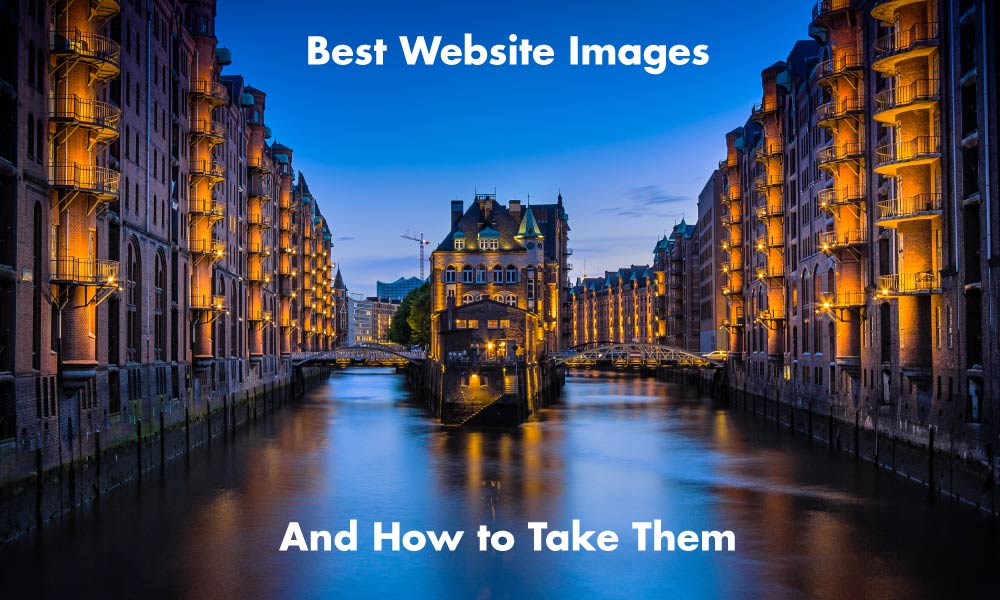
The best creative web design for clients all have one thing in common; image quality. Images are the number one visual way information is communicated and in the day and age of increasing demands for quick information, images do a great job at telling a story quickly for site visitors. Images are crucial for efficient web design because they break up content on pages which can be overwhelming for visitors. Essentially, people want information fast, and when they don’t get the answer to a search phrase, they leave the site (contributing to high bounce rates, low conversions, and lowered SEO scores). What better way to convey information quickly than through pertinent images paired with good keyword-heavy content aiming to match a visitor’s search phrase?
Efficient use of images can be hugely beneficial to a site and can add to a business’s branding, their tone toward visitors, their business’s image, efficiency in converting visitors, guiding efficient site-navigation, SEO, and much more. Images work hand in hand with creative web design and are increasingly recognized in their importance in conveying information:
“A common finding is an observed processing superiority of pictures as compared to words, suggesting that pictures have a faster and more direct access to meaning, while words are discussed to require additional translational activity...” -Schlochtermeier, et al. (2013).
Given the importance of images to visitors, it is good to know what constitutes as good images for a website to make the most of creative web design.
When people think of the best web design they typically only think of a site’s layout. However, most people forget that a large portion of layout is where to place high-quality images and content. The best web design is unique for each client and their business. However, there are similarities with site layouts and how images are arranged:
Simple and effective designs use layouts with images that do not confuse visitors, help them navigate the site, sell your unique message, and help convert visitors into a customers. Good layouts also use images to guide visitors toward pertinent pages or locations on their site.
There is a misconception that images need to be small for a website. Images need to be as big as possible to get high resolution, only their file sizes need to be small. Thankfully OCG takes care of all file compression so even if you give us massive photos, we ensure they are optimized on your website. Images that are too small are 'pixelated' or 'low-res' and look bad on websites and can hurt your online appearance and brand identity.

High Res Image

Low Res Image
The images need to be well lit. Avoid using a flash because it tends to wash out all images. The main source of lighting should not be behind the subject either and you should avoid highly contrasted images that add a lot of distracting patterns. This is very important because many images on a website have text over them and high-contrast images make it difficult to read the content and can be strenuous to look at on their own.

Good Lighting

Bad Lighting
Having everything in focus can make the image too cluttered and distract from what you really want to viewer to see in the image. A ‘soft-focus’ pulls the viewer’s eye toward the object you want site visitors to pay attention to while softly blurring the rest. This can also help de-clutter busy images.

Good Focus

Bad Focus
Many people think that if you want to draw attention to something it needs to be centered in the image. That can get repetitive with many images on your site. Take images from close up and far away with the subject in different places. It can be a mistake to take all of your images from one perspective using one composition, unless you are taking product shots.

Good Composition

Bad Composition
You may hear web-designers or account-coordinators talking about ‘mastheads’. Mastheads, banners, or site headers are the images that display at the top of each web page. These images need to be large (to work with a responsive website) and need to be ‘landscape’ not ‘portrait’. Additionally, because visitors only see a tiny part of the whole image, it is a good idea for the image to capture 'depth’. For example, instead of taking images from a top-down angle on a subject, try taking shots from different angles that emphasize perspective. A good way to do this is taking a series of images starting from the ground-level and moving up.

Good Perspective

Bad Perspective
Many clients find sites and ask what we can do to make their site more like the example they choose. The most common site people tend to ask for is Apple or other sites for technology companies. So what do they do that makes their layout work so well?

Imagine you’re in a library doing research for a college paper. All of the books are thrown into a pile on the floor. You basically have to swim through the books to find what you’re looking for. The best book ever might be buried in that pile. But, what are your chances of finding it? The same goes for content. Content visibility can be met through internet marketing efforts. You can write really great content, but without a solid strategy to back it up, it’s going to prove tough to compete with the big competitors. With more than 92,000 articles posted on the internet every day, the competition is tough. WordPress users alone produce over 35.8 million new posts a month. Digital media publishers, like Huffington Post, are known to publish anywhere up to 1,500 articles a day. How does your small business stand a chance? You must develop a content strategy that positions your business as an expert and gets you noticed online. Here’s how you can increase your content visibility and get it noticed:
Implementing a great content strategy increases the chances of your article or blog getting found online. Don’t let your business get buried under a pile of books. Get organized, get your key-words, in order and get in the card-catalogue of the internet.

The weather is perfect. The DJ has mixed a super cool play list. The food is exquisite and the drinks are cold. This will be the best party ever…if the guests ever arrive! Cue the screeching tire sound effects. OMG! You forgot to send out the invites. Spending time, energy and money on a great website without internet marketing is just like throwing a fabulous party and not inviting anyone. What’s the point? Throw that online party! Plan it, send out invites and be the talk of the town.
1) Guest List: Target your market. Who are the people you want to come to your site… the ones that have a need or interest in your services? Identify and invite! 2) Invitations: How are you going to get your target market to attend? Do key word research and present relevant content that attracts them to your site. In web lingo, this translates to SEO, blogging and social media efforts that increase your organic search rankings. 3) Entertainment: You got them there, now what? Make sure your decorations are awesome and the guests are having fun. In other words, make sure your site has a simple, clean design; is easy to navigate, has spectacular photography, custom iconography and info graphics. The better the experience, the longer they’ll stay. The more engaged they are, the better chance you have to convert them to a client. 4) Don’t leave yet! Check your key performance indicators: traffic volume, reach, profit goals, ROI targets and demographic spread. Evaluate and make adjustments accordingly to keep clients on the site longer and coming back for more! Having the proper tools for accurate reporting is most helpful. 5) Party Favors: They like your party, so send them home with something meaningful. A downloadable pdf with great industry tips…A free consultation…A sample of your most popular product. 6) Update your address book: Or your CRM. You’ve met all these new friends, so stay in touch. Get an email address so you can send interesting facts, industry updates, links to blogs, weather and travel tips. Invest in the lifetime value of a client and you’ll keep them forever.
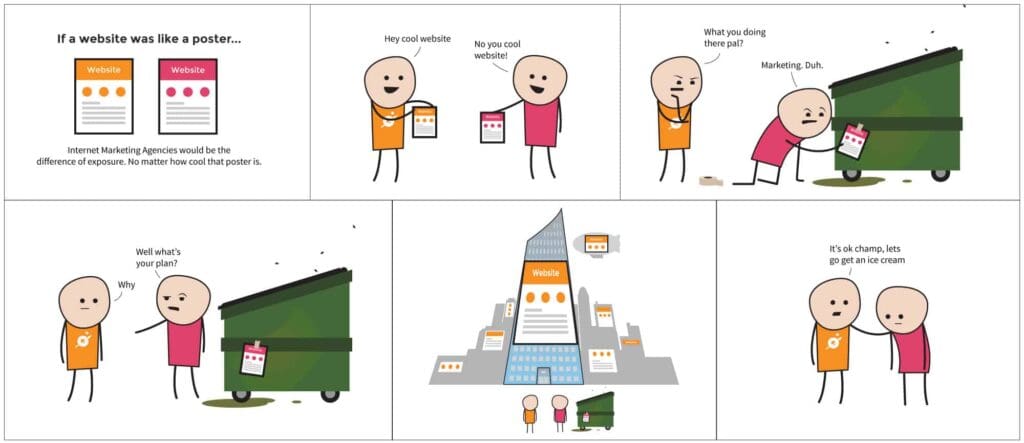
Creativity reigns supreme right? It is common knowledge that only the coolest websites get top exposure. Part of me, as a web designer, hopes this would be true. However, creative web design only takes a business so far. Ultimately, there are thousands of terribly designed websites that get more traffic than award-winners. If you want your website to work for you beyond a cocktail party talking point, then you need to know that Web Design is a part of Internet Marketing and not the same thing.
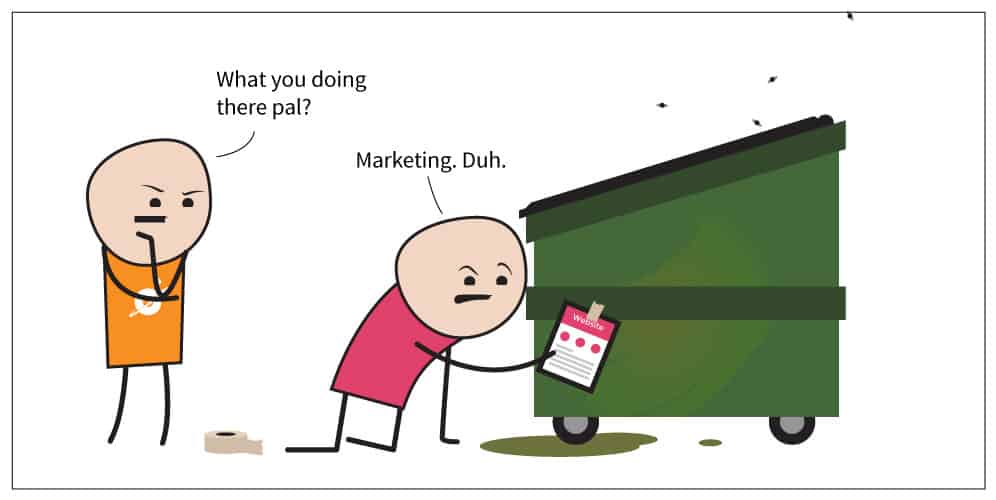
As cleverly explained by the cartoon, you can have the most creative and interesting website in the world, but if you market it horribly, then not many people will see it and you won’t get a very good return on your investment. OCG Creative’s team of dedicated and nerdy Reno web designers and developers work hard to produce these award winning sites. We have done this for numerous clients for many years. Part of the creative web design also involves the user’s experience with the website, which is why an analogy of a website being a poster is only part-true. In reality, a website is a fluid document – it changes with input from the user and looks different on different devices. OCG works to build the coolest website imaginable for our clients, but we know at the end of the day that it is essential to market it correctly, and websites should never stop when the design is completed.
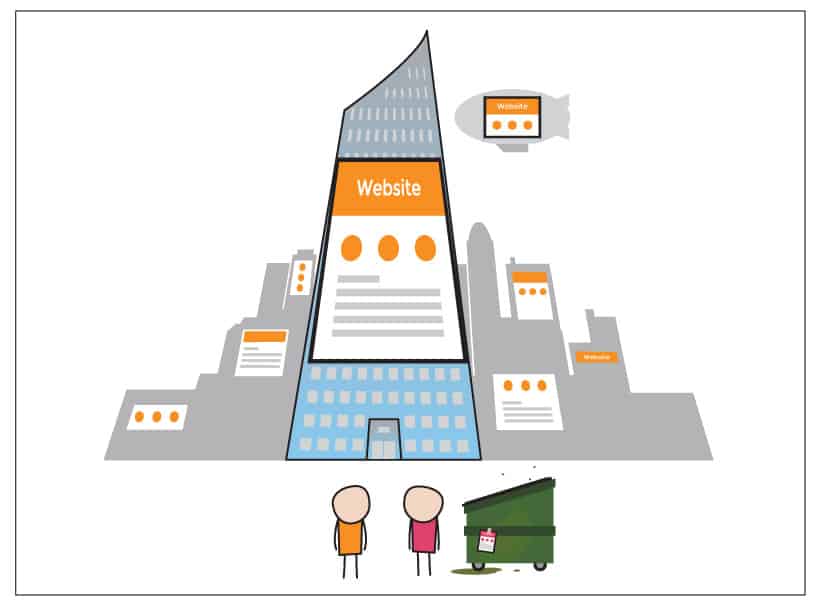
As a secret confession, I used to wonder this question all the time. There are plenty of online tools to build a website, and before I became a web designer, I even built my own portfolio using one of these tools. The issue with all of them… they’re awful. Even discounting the fact that all of them stop at the end of web design, the web design itself is clunky, confusing, and very limiting. I didn’t realize this until I experienced it first hand. A website should never stop at the end of creative web design. Instead, it should be a rocket-powered branding piece pushing the client forward to more exposure and spurring the start of a comprehensive effort to convert website visits into leads. OCG custom designs each website so it is beautiful and branded, but most importantly, they are scalable and sturdy for expansion in traffic and tailored to convert site visitors into customers.
After website design is completed, many people stop and never touch it again. It’s similar to making a cool poster and then never posting it anywhere. Why? Internet marketing takes effort, DIY site builders don’t have the resources to market each site created and the sites themselves are cluttered and reject efforts to market them. A lot of this is due to lack of on-site SEO support in addition to other elements such as effective landing pages and lack of Conversion Rate Optimization. It is much easier to stop after finishing the web design part.
The point is, OCG Creative is a dedicated and experienced Reno web design and internet marketing agency that has the resources. Websites should be built to be optimized for internet marketing. The issue with DIY site builders, is the website's inability to integrate with a meaningful and comprehensive marketing campaign for individual clients. This is because DIY sites purposefully exclude any means of integrating with an internet marketing plan, it is simply too much effort for DIY site builders to accommodate these features. Internet marketing takes time and a sturdy website foundation specifically built for internet marketing. Additionally DIY site builders don't want to manage campaigns because they take time and constant tuning. Hard work with SEO, Landing Pages, CRO, and other services, take time to gain traction. OCG maintains these campaigns, constantly tailoring our client’s Internet Marketing plans to coincide with optimal conversions including tracking page visits and valued keywords to get them ranking higher. You can’t get that level of detailed attention with do-it-yourself websites. It takes significant time, specialized data collection, and informed decisions to be implemented after data collection to market a website correctly.
If you’re not sure where to go from here knowing all of this or if you still think an awesome looking website is the most important thing for you or your business, give us a call or browse our other topics. We’ve been doing this for a while and know the internet marketing world front and back.

In Part I of this article, we explored primary website performance metrics and ways to ensure your data isn't influenced by scumbag spammers. Now that you're looking at unbiased numbers, let's explore ways to make sure your efforts align with the goals you have for your business.
To get there, it is worthwhile to reexamine your business goals and make an assessment about what matters most. It's easy to set broad goals like "get more sales," or arbitrary goals that have no basis in history or reality. An example of that might be a 100,000 monthly visitors to a new website, growing organically from zero.
For a goal to be valuable, it needs to specific, measurable, achievable, realistic and time-bound. You may recognize that as the formula for a SMART goal. There's lots of discussion about SMART goals in business school and around the web. Measured this way, you can see that my first example, "get more sales" isn't specific. The second, 100,000 monthly organic visits, probably isn't realistic.
A brand new website, on a new domain with all new content is going to have very different goals than a website that is already competitive. At this stage, your goal should be to get everything right, and lay a foundation to become truly competitive as your website gains traction.
At this point, traffic and visitor goals are far less valuable than those related search engines. Setting aside PPC (AdWords, etc.), if your website is genuinely new, your goals should center around what you can control.
1) Website content. Most owners of new websites get completely wrapped up in the design. In reality, the website design is secondary to the writing. Most of the time, the best way to improve a website's design is to take half of it out, but that's a topic for another day.
Online, it's your writing that brings new business. In the beginning, your website content is the one thing you have 100% control over. It's also the most important factor related to search engine rankings. So, if you are not a good writer, you have two options—either hire a good writer, or become one.
Website content goal: Write and publish a greater volume of better, more complete, compelling and interesting website content than your strongest competitor.
To make your website content goal a SMART goal, make it tangible and set dates.
S = Specific: List your top competitor's webpages. Paste each page into a word processor to get a word count. Jot down a list of keywords used on the page and note the number of times each one was used. Make an additional note of any text links and where they go, as well as all levels of headings used throughout the website. Do this for EVERY PAGE, even if it takes a week or more.
M = Measurable: Having quantified the the website details of your toughest competitor, next you'll need to decide what to measure. In this case, you don't need anything more than a word processor. When you have more pages, with better focused, better written copy, using the same keyword density, plus at least as many links, you're good… for now. Measuring these items is as simple as counting.
A = Achievable: This goal is achievable as long as you, or someone you hire has the skill to write meaningful website content. It must follow the "rules" you outlined by assessing your competitor's website. As long as you know what to write, and have the ability to do it, this goal is achievable.
R = Realistic: If you are writing your own website content, the only thing you need to assess is whether or not you will actually do it. We, as business owners, are an industrious lot. We do things ourselves and tend to take on a lot. You are probably very busy running your company. Is writing and editing what could be tens of thousands of words really realistic? If not, you may want to hire a writer.
T = Time-bound: So far, so good, but it's not a goal until you set a date to finish. Some people can write 600 words an hour. Others take 600 hours to write a page. Set your deadline based on your business objective, balanced with a reasonable assessment of what you are capable of. There is an "opportunity cost" for not having your website published and ready to compete. Don't let excuses or your own busy schedule set you back. If it looks like plan A is going to put you beyond your deadline, have a plan B ready to go. [coach voice] This is business, people, so let's make it happen.
2) Unique Titles and Descriptions. This is SEO 101 kind of stuff—something I like to describe as the Onsite SEO Top 5. Our content goal covered the first three items; keyword density, headings and anchor text (the actually words used for links). That leaves page titles and descriptions.
HTML TITLE Tags: The page title is created by using a special tag in the head of the html document used to create the page. The browser loads this page and displays your title in the browser tab. More importantly, search engines display your title as the link in the SERP (search engine results page).
Google, Bing, Yahoo! and all the others use this title as a primary means for determining what the page is about. Therefore, it makes sense that these should include your target keywords. Making sure they do should be standard practice. Your titles should match the content of the page, and also be unique. Don't use the same title for every page on your website.
Meta Descriptions: The head of your html document should also contain a meta description. There is considerable debate over the direct value of the description relative to SEO. Nevertheless, you should ALWAYS include a unique description on every page of your website.
Like the page title, the meta description you write will be displayed in search results. This is the descriptive text just below the line containing the webpage URL.
You should always use keywords in your meta description, even if you don't believe they will have an impact on rankings in Google. This is because a) searchers will often read the description when deciding whether or not to click the link, and b) Google is not the only search engine. (Though it does seem like it is.)
Make unique titles and descriptions part of your content goal. It's not as technical as it sounds. Many content management systems have built-in tools for including these. If you are one of the millions of WordPress users, a plugin like Yoast SEO will make your job easy. The challenge will be making them unique and readable for humans, as well as search engine spiders.
I framed this as a content goal for new websites, but if you haven't already done so, you should make a similar assessment even if your site has been online for time and is performing well. Website content forms the foundation of your online marketing strategy. It is vitally important that you keep your online content competitive and up to date.
The working word in that statement is competitive. With every passing day, the likelihood your competitor will hire a top SEO firm to crush you, increases. To combat that, you need to pay attention to what's happening around the Internet relative to your market or industry.
It is important to realize that without sufficient website content, nothing you can do will achieve a consistent, stable result. In nearly every case, websites that are thin on online content will suffer, not only in rankings, but with visitors seeking information.
Part III of this series will focus on taking your effective Internet marketing strategies to new heights. To do that, we'll put out nerd hats on and dig deeper into the data. In the mean time, feel free to email me (joe@ocgcreative.com) or comment below with your questions or comments.